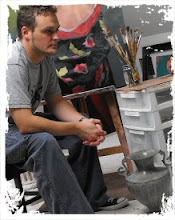Below is the essay I submitted as part of Vasari Paint’s annual essay content in December of 2012. I wrote this essay as a response to the question posed for the competition; “Does Robust Color Make For a More Successful Paint?” It is roughly a two page submission which outlines my perspective. Thank you.
Vasari Essay Contest
Billy Seccombe
9/27/12
"Does robust color make for more successful painting?"
The use of robust pigments in fine art painting results in a more highly successful painting because the process of painting itself becomes simplified, or at the very least...easier. That is, when a full-bodied pigment is applied which is void of commercial fillers the process of color mixing becomes easier and the ability to achieve the color observed happens faster and with a greater ease. Thus, achieving more accurate results. With rich pigment, an observed color may be achieved with two or three steps as opposed to four or five when mixing with lower quality paint requiring considerable more time and effort on the part of the painter. The color achieved in this manner then appears over-worked and often muddy. It is seeming flat and void of intensity. The fact is, fillers and synthetic pigments produce bland, flat color and as a result, the painting does not sing on the wall but rather hangs quietly with a muted and dirty overtone.
The quality of the artist's paint eliminates wasteful actions and unnecessary over compensation in the artist’s struggle to bring forth a certain brilliance which simply cannot be accomplished through lesser means. By applying a higher grade product the act of painting itself is reduced to a more immediate response.
The fragmentation of stopping and starting as the artist mixes and applies the mixture to his canvas is thus shortened. As a result, the painting occurs more rapidly and spontaneously. Robust color helps to speed this process as it becomes one fluid motion of observation and recording resulting in a piece which is more likely to capture initial impressions and the energy of the moment or the essence of the sitter. Moreover, the ability to capture subtle shifts in value and warm or cool tones throughout the form are made more lively and life-like as the surface become more clearly defined.
Learning how to paint with a lower quality, less pure paint stifles the art student and the path to understanding will be jagged. The art of painting is hard. It requires skill and patience. It is not for the faint of heart and as one attempts to create a great masterpiece he must first be armed with an arsenal of knowledge, skills, and superb materials. To endeavor to create a painting with poor materials is akin to setting sail on a trans-Atlantic voyage in a ship made of kindling. One cannot expect great results in a work without strength in the very medium that holds the piece together. An artist cannot use a brush with loose bristles, or a canvas that is warped, or paint produced with fillers and waxes if he is to achieve greatness in a work.
Additionally, in valuing the techniques of Old Master approaches and time-tested methods of drawing and painting, contemporary artists today must embrace the materials of the past if one is to truly become a great painter.
The value of hand-made, robust pigments produced in a fashion that pays particular attention to detail and includes only the purest of ingredients assists in the creation of top-quality work as it ensures a longevity to the work itself and as it continues to thrive far beyond the artists life. It will take on a life of it's own and the importance of pure colors will guarantee a painting that remains life-like for years to come.
Color, after all, is the result of light and to mix color with a paint that is poorly made and without an attention to pure, robust ingredients makes the process of mixing paint and achieving accurate colors that much more difficult. It is vital to begin with the proper materials. Thus, one begins at a disadvantage otherwise and the painting despite the artist’s best efforts, may only reach a fraction of it's fullest potential. Robust color in painting does make for a more successful painting.
Billy Seccombe
www.billyseccombe.om
https://twitter.com/wseccombe

























































